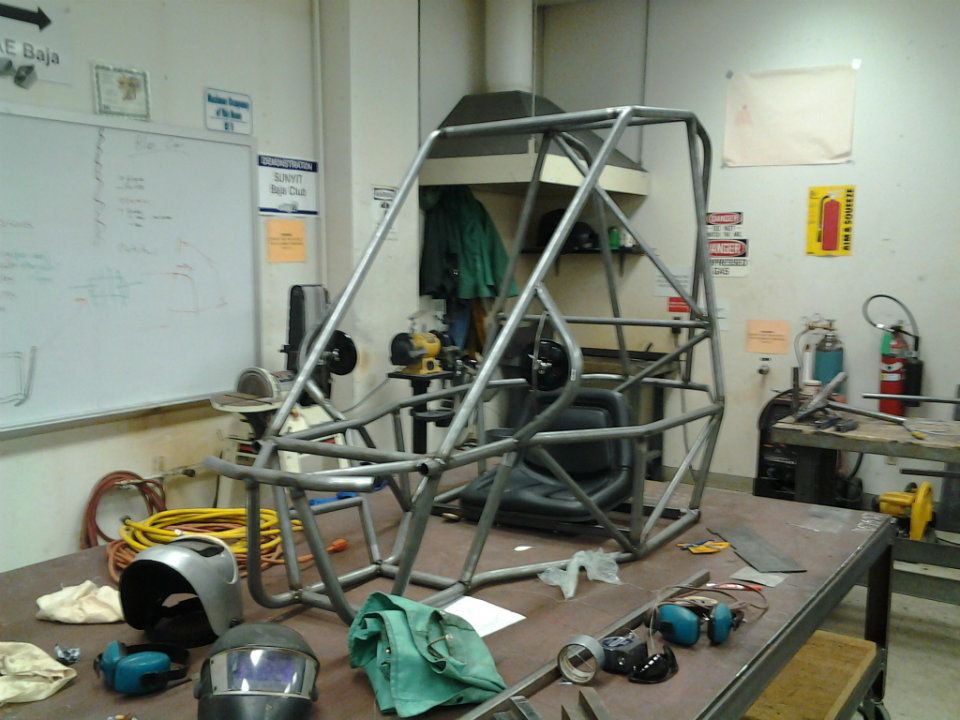Technically being built in the 315, but I figured I would start a build thread for this year’s baja car.
Background:
Baja SAE is a student design competition run by the Society of Automotive Engineers, in which participants research, design, fabricate, test, and finally race an off road vehicle. The vehicle in question is a single-seat off road buggy, intended to potentially be a consumer product aimed at a “weekend warrior” type of off road enthusiast. It must be capable of traveling over rough terrain (rocks, logs, dirt, mud, jumps, etc), be small in size to fit through tight trails, have nimble handling, and also have loads of torque and traction (one of the events is a pulling test/mini tractor pull).
Teams are restricted to several frame design guidelines (tubing wall thickness, specs on unsupported lengths, driver clearance, etc) mainly for safety reasons, and also restricted to the use an unmodified 10hp Briggs & Stratton engine, governed to 3800rpm. Everything else is wide-open.
Events consist of Acceleration, Pull, Maneuverability, Suspension & Traction, Mud Bog, and the 4 hour Endurance Race.
Teams come from all over the country and world for this. Last year there was a team from Brazil in the pit next to us, we were across from RIT, and there were teams from India as well.
I won’t be down at the shop until tomorrow, so my pics of current progress are a bit limited, but I’ll be adding to this thread over the course of the year, up to and including when we go to Rochester for competition in May.
Here’s last year’s car:

Unfortunately to pass tech, we had to add the two short angled square tubes at the top right of the cockpit.
During the Suspension and Traction event:


Flex test of last year’s car in the shop:

On to this year:
The old frame was uncomfortable for drivers over 5’4" tall. Fine for a hardcore race vehicle, but not fine for a consumer product. This year’s frame focuses on much greater cockpit space. I’ll get a pic of it when I get down to the shop on monday.
I’m heading up suspension design this year, and have the basic geometry for the front suspension worked out in solidworks (there’s a lot of stuff hidden in that drawing for legibility’s sake):

Basics: A-arm front suspension, 11 inches of ground clearance, about a foot of suspension travel (assuming we can keep the steering from binding), roll center located about 9 inches off the ground to shrink our roll couple somewhat (past designs did not take roll centers into account). 3.5 degrees of static camber, with enough camber change over the course of the suspension stroke to stay ahead of body roll without getting too absurd if we stuff the nose of the car (a problem in the past, balloon-like ATV tires with poor sidewall stiffness + 1.5 degrees of static camber + 1 degree camber gain + 5 degrees body roll = sadness). If I remember correctly, the arms are something like 18 inches long from center of the inner pivot to the center of the heim joint on the end.
We are looking at running a stepped arm design to widen our area of max ground clearance. The arms are also longer than in past years, which will hopefully limit how much the car gets kicked around in the really rough stuff.
Rear suspension is a simple independent trailing arm design (last year pictured below, this year isn’t going to look all that different). It works, I wish it had more aspects to fiddle with (I personally want to go multilink), but the team is fairly rooted in tradition, so that’s not happening. In the past we have had problems with running out of plunge depth on our half-shafts, hopefully going to get around that this time. There are a few ideas bouncing around.
Drivetrain consists of a 10hp briggs & Stratton, centrifugal clutch to chain primary drive to harley davidson Ultima 6-speed transmission, to a chain final drive to the rear end, which is a spool with an inboard disc brake. Most teams run CVT’s of some sort or other (usually a Gaged or a CVTech), but in the past we had problems with CVT tuning and switched to sequential manual. This year we are developing a pneumatic shifting setup to do away with the heavy mechanical linkage that has pretty much always been a problem for us.
During the endurance race, we broke our rear end and lost the inner CV cup out on the course. We had a spare axle, but it was too long, so it was installed and the suspension on that side was locked with a solid bar in place of the air shock. Ride quality suffered a bit. Still, you get the idea of what the rear suspension consists of.

So yeah, KrazyKid level wall-o-text over. Future updates will be much shorter now that the basics are out of the way. Oh, and if anyone is wondering, it goes about 35mph. Fastest cars there can do about 40, one car supposedly is knocking on 45mph.


